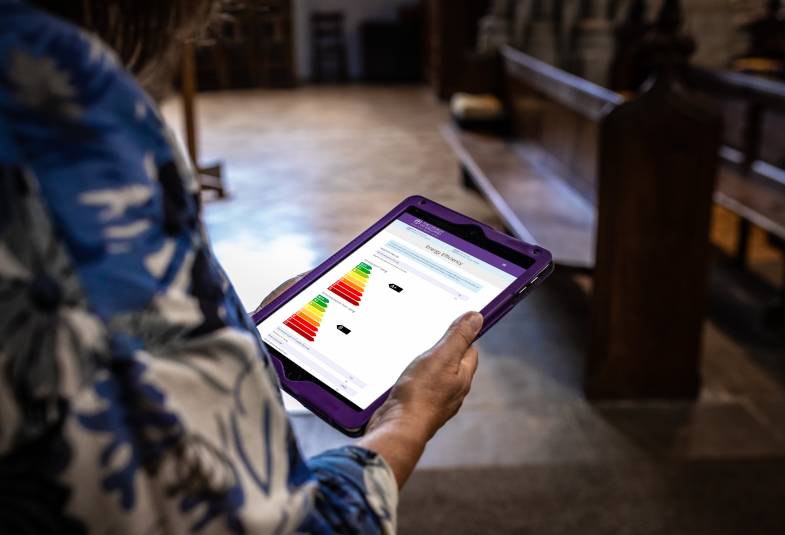
Record temperatures: The June - July - August (JJA) season for 2023 was the warmest globally by a large margin. And records were broken across the world together with extreme climate events. What can we do to help slow this trend and to demonstrate our love for God's creation? Cutting our church's carbon footprint is one way. Every little bit we do counts.
The easy-to-use Energy Footprint Tool will tell your church what your "carbon footprint" is, based on the energy you use to heat and light your buildings. You can find it on the Online Parish Returns System.
The Energy Footprint Tool has now opened for entry of 2023 data. Your 2023 data should be submitted by the end of July 2024.
How does the EFT work and why should I do it?
To find out how it works, read the instructions sheet here, and watch a short instructional video, created by the Dioceses of Guildford, Chichester and Portsmouth. For background information, watch the Eco Church webinar on Net Zero Carbon at https://www.youtube.com/watch?v=QbXYnqGUmzo
The Energy Footprint Tool will tell your church the amount of carbon produced annually by heating and lighting your church buildings. There are two useful graphs that show you your efficiency scores: one for energy efficiency based on building size and one for attendance. It can take account of separate buildings such as church halls, as long as you have the utility bills for them.
What benefit is it?
This EFT helps reduce your church’s contribution to climate change and demonstrates care for creation, as part of the Fifth Mark of Mission of the Anglican Communion. Across the world, people are being affected by drought, flood and fire and we are seeing this more and more, even in the UK. Every little bit we can do helps, and it also changes the tide of public opinion.
What information do you need?
You will need your utility bills for the year before; electricity, gas, oil, or whichever other fuel you use. For example, if you are completing it in 2024, you need your 2023 bills. If you have solar panels, information on their generation over the preceding year.
If you want to include a separate church hall or other building, then you need the bills for this too. If you want to exclude an area which is permanently rented out to tenants and sub-metered, you will want this information to hand.
You can find a paper copy of the questions here.
For most churches, we already know the floor area. If we don't already hold this information, you will need a sensible estimate of the floor area of the church in square metres, and any other associated buildings you are inputting, such as the church hall.
You will also need a sensible estimate of the number of person-hours that the church is used throughout the year. Please remember when entering this data that a good estimate is fine – these numbers do not need to be 100% accurate, and as long as they are in a relevant ball park.
To help you calculate the size and usage of the church, you might find this template helpful.
Is the cost of the electricity and Gas per kWh or the total bill charge (which would include daily standing charge and VAT) required?
Yes! On the form, you will have to enter the name of the supplier, kWh of electricity purchased for 2023 and the cost of the electricity.
Similarly, for gas, enter the name of the supplier, the amount purchased, specifying the units (whether kWh or cu metres or 100s cu feet) and the cost of the gas.
These can be done by recording the values at the start of the year and at the end from your meters, OR from your bills OR by submitting how much you paid. If you submit your bill charge, the amount you actually use will be taken into account. NB Did you pay VAT at the reduced rate for churches?
Who looks at the data?
Data is analysed by the Research and Statistics unit of the Church of England. We can also look at EFT parish returns locally. This helps the diocese to see what progress we are making towards our 2030 target. It also helps us as we try to identify and offer support and other resources to our largest emitting churches to help cut their carbon footprint.
Once we know our carbon footprint, what next?
The tool also offers some helpful tips to reduce your carbon emissions. Using the tool each year will help you to track the impact of the different steps you are taking to reduce your carbon footprint.
You can use the Practical Path to Net Zero Carbon to plan your action, and the Net Zero Carbon church webpage to get information. Refer to the Church of England's net-zero carbon webinar programme and see how Parish Buying can support you.
Cutting energy costs:
Some of you may find this page on the Church of England website useful to share with your parishes this winter: Heating your church this winter | The Church of England